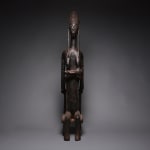Bambara Guandousou Queen Figure, 20th Century CE
Wood
116.8 x 22.2 cm
46 x 8 3/4 in
46 x 8 3/4 in
PF.3636
Further images
This elegant piece is a Guandousou “queen” figure from the Bambara/Bamana group of Mali. It is a good example of the genre, with short legs reaching the ground from a...
This elegant piece is a Guandousou “queen” figure from the Bambara/Bamana group of Mali. It is a good example of the genre, with short legs reaching the ground from a low “throne”, an elongated torso, pendulous breasts, a long neck and a tall, serene face surmounted with a headdress. The upper arms are banded with incisions denoting jewellery, and she is supporting a small child to her left breast.
The Bambara/Bamana is one of the largest groups in Mali and lives in a savannah grassland area that contrasts strongly with the Dogon heartland. Their linguistic heritage indicates that they are part of the Mande group and gave rise to the Bozo, who founded Djenne in an area subsequently overrun by the Soninke Mande (<1100 AD). Their last empire – the Mande-speaking Songhai – dissolved in the 1600s, and many Mande speakers spread out along the Nigeria River Basin. The Bamana empire arose from these remnant populations in around 1740. The height of its imperial strength was reached in the 1780s under the rule of N’golo Diarra, who expanded their territory considerably. However, their influence waned in the 19th century and the empire fell to the French in 1892.
Their society is Mande-like overall, with patrilineal descent and a nobility/vassal caste system. Age, sex and occupation groups are classed by “ton” – societies that reflect their social importance (age- or sex-related) or work (i.e. hunters, farmers). There are four main mask forms, in addition to the famous Chi-Wara headcrest, which was used to encourage good harvests. Heavily encrusted zoomorphic “Boli” figures are also known, along with everyday items include iron staffs, wooden puppets and equestrian figures, which double as accessories for male initiation ceremonies. Their anthropomorphic door locks are especially well-known.
The Guan society is responsible for the maintenance and use of most sculptural forms, notably the Guandousou “queen” and the knife-bearing “Guantigui” statues. They are usually exceptionally refined and tranquil pieces, contrasting strongly with the rather more dynamic but less linear “Dyonyeni” forms, made by the Dyo or Kwore societies, usually representing hermaphrodites with large, conical breasts.
The use of decoration is often very simple, adding to the magnificence of the piece without losing any of its character and awesome fascination. This proud and protective Mother gently cradles her child while it suckles contentedly in her arms. While the Mother is seated in a straight-backed chair, her naked torso is elongated, accentuating her slender neck and her long, slim limbs. The perfect symmetry of her facial features shows a delicate handling. Her arms are decorated with amulets and her hair, beneath a simple cap, is neatly divided into braids and secured with small circular rings. She is the image of contentedness and a testimony to the beauty of the women of the Bambara tribe.
The Bambara/Bamana is one of the largest groups in Mali and lives in a savannah grassland area that contrasts strongly with the Dogon heartland. Their linguistic heritage indicates that they are part of the Mande group and gave rise to the Bozo, who founded Djenne in an area subsequently overrun by the Soninke Mande (<1100 AD). Their last empire – the Mande-speaking Songhai – dissolved in the 1600s, and many Mande speakers spread out along the Nigeria River Basin. The Bamana empire arose from these remnant populations in around 1740. The height of its imperial strength was reached in the 1780s under the rule of N’golo Diarra, who expanded their territory considerably. However, their influence waned in the 19th century and the empire fell to the French in 1892.
Their society is Mande-like overall, with patrilineal descent and a nobility/vassal caste system. Age, sex and occupation groups are classed by “ton” – societies that reflect their social importance (age- or sex-related) or work (i.e. hunters, farmers). There are four main mask forms, in addition to the famous Chi-Wara headcrest, which was used to encourage good harvests. Heavily encrusted zoomorphic “Boli” figures are also known, along with everyday items include iron staffs, wooden puppets and equestrian figures, which double as accessories for male initiation ceremonies. Their anthropomorphic door locks are especially well-known.
The Guan society is responsible for the maintenance and use of most sculptural forms, notably the Guandousou “queen” and the knife-bearing “Guantigui” statues. They are usually exceptionally refined and tranquil pieces, contrasting strongly with the rather more dynamic but less linear “Dyonyeni” forms, made by the Dyo or Kwore societies, usually representing hermaphrodites with large, conical breasts.
The use of decoration is often very simple, adding to the magnificence of the piece without losing any of its character and awesome fascination. This proud and protective Mother gently cradles her child while it suckles contentedly in her arms. While the Mother is seated in a straight-backed chair, her naked torso is elongated, accentuating her slender neck and her long, slim limbs. The perfect symmetry of her facial features shows a delicate handling. Her arms are decorated with amulets and her hair, beneath a simple cap, is neatly divided into braids and secured with small circular rings. She is the image of contentedness and a testimony to the beauty of the women of the Bambara tribe.









